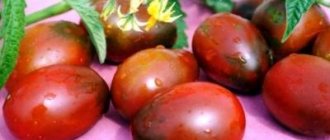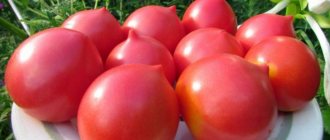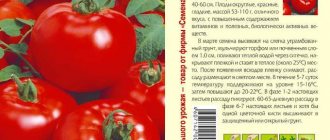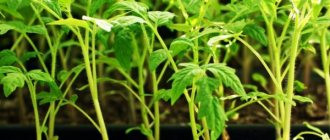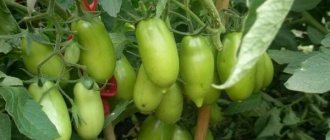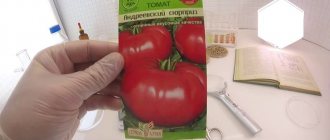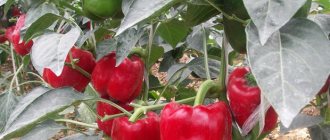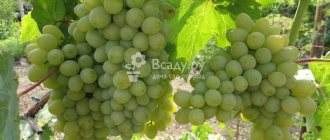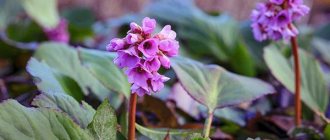Tomato Peter F1 is not very well known in the market and gardens, but it is perfect for individual cultivation and for sale. It ripens early, and the fruits have an excellent taste and have a beautiful shape that will delight those who are interested in canning.
| Height | Landing location | Ripening time | Fruit color | Fruit size | Origin | Fruit shape |
| Tall | Greenhouse | Early ripening | Reds | Average | Hybrid | Heart-shaped |
Description and characteristics of the variety
Tomato Peter “Siberian Garden” is a tall indeterminate hybrid with a height of 2-2.5 m. It is poorly leafed. Forms simple brushes, each containing 6-8 tomatoes. The fruits are medium-sized, 130-150 g each. Their shape is slightly reminiscent of an egg - it is elongated and heart-shaped. The color is deep crimson. The taste is excellent. The hybrid gives a good commercial yield and can be grown for sale.
Peter F1 should not be confused with more well-known varieties that have similar names: Peter the Great and Peter 1.
Features of cultivation, planting and care
We recommend sowing the seeds of this tomato variety for seedlings 55-60 days before the intended planting in the ground. Seedlings dive at the stage of two true leaves. When planting seedlings in a permanent place per 1 sq. Place up to 5 plants per meter of plot.
Further care for tomatoes consists of timely watering, pinching, weed removal and preventive measures to protect against diseases and pests. We recommend forming the plant only up to the first flower cluster.
You can see other interesting varieties and hybrids of tomatoes with photos, descriptions and reviews in our Tomato Catalog. Enjoy watching.
If you grew Peter 1 tomatoes, please write whether you liked them or not. What was the yield and taste of the fruit? Will you grow them again? If possible, attach to the comment a photo of the entire bush as a whole or individual fruits that you grew. Thank you!
Your reviews of the Peter the First tomato and additions to the description will help many gardeners evaluate this variety objectively and decide whether it is worth growing or not.
This is a natural variety of tomato. Therefore, we recommend taking seeds from a ripe fruit and using them for planting in subsequent seasons.
Advantages and disadvantages
The main advantages of the variety are considered to be high yield combined with good taste of vegetables. The plant has a high degree of resistance to diseases of fungal and viral origin.
Description of the benefits of the variety:
- resistance to unfavorable growing conditions and environmental factors;
- possibility of using seed material;
- good yield and taste of tomatoes;
- plant resistance to diseases and pests;
- no need for pinching and tying.
Significant features and disadvantages are unusual for the variety. If there is insufficient heat, some fruits do not have time to ripen fully on the bushes. In this case, they are put in a dark place until they turn red.
Features of agricultural technology of EM Champion tomatoes
The agricultural technology of tomatoes of this variety has some nuances.
Landing
Since, as a rule, these tomatoes are not grown without seedlings, you will have to take care of preparing the seedlings. To do this, first of all, you need high-quality seeds, which are purchased from trusted manufacturers or their dealers, and you can also harvest seeds yourself, since the variety is not a hybrid.
Tomato seeds EM Champion of the Siberian Garden trademark are of good quality
The time for sowing seeds in the middle zone is the first half of March. Seedlings need picking when two or three true leaves form. In the first half of May, when the plants reach 60–65 days of age and have 5–6 true leaves, the seedlings are planted in the ground. If at this time there is still a possibility of return frosts, then the beds should be covered for the first time with spunbond or film along pre-established arcs.
You should also take care of installing supports in advance - these can be wooden stakes about one meter high above ground level, driven near each bush. But, in my opinion, trellises or cords hanging from the crossbar of a U-shaped support are more convenient. In this case, it will be easier to quickly tie up individual clusters with a large number of fruits.
It is convenient to tie tomatoes to hanging cords
It is more convenient to grow these tomatoes with a two-line planting pattern with a distance between rows of 50 cm. Due to weak foliage, the interval between bushes can be small - 30-40 cm.
The rules for growing EM Champion tomatoes do not require much labor.
Shaping, trimming and tying
You can leave these tomatoes to their own devices and let them grow on their own. And they will grow, but they will form a large number of small fruits. To prevent this from happening, you should:
- Tie up the stem and branches with fruits in a timely manner.
- Trim the lower leaves back to the first cluster.
- Seedling the bush, leading it into 1-3 stems.
- Normalize the harvest by thinning the clusters. The degree of thinning depends on the preferences of the gardener - the fewer fruits left, the larger they will be.
Watering
To grow large fruits in sufficient quantities, the plant needs strong and branched roots. For their development, the planted seedlings are moistened abundantly when planting, and then watering is stopped for 3-4 weeks. At the same time, in search of water, the roots will grow laterally and in depth, and as a result form a powerful root system. Subsequently, water the tomatoes abundantly at intervals of 7-10 days. Water for irrigation should be warm - for this it is stored in barrels installed in a sunny place. After watering, the soil should be loosened and mulched with available materials - hay, peat, rotted sawdust, sunflower husks, etc.
Feeding
EM Champion tomatoes are responsive to fertilizer application. Regular feeding will help you get a good harvest of large and tasty tomatoes. For this purpose, it is best to use natural liquid infusions of homemade preparation. Infusions of mullein, chicken droppings, or ordinary freshly cut grass are excellent as nitrogen fertilizers. To do this, they are loaded into a barrel and filled with water. After 5-7 days of fermentation, the liquid is filtered and used for fertilizing, first diluted with water five times (chicken manure infusion - ten times). 2 liters of fertilizer are poured under each bush.
Mullein infusion is an excellent nitrogen fertilizer for tomatoes.
To obtain potassium-phosphorus fertilizer, 3 liters of sifted wood ash are dissolved in a bucket of water and left for 2-3 days, after which 1-2 liters are watered at the roots of the bushes. Such fertilizing is started simultaneously with the resumption of watering after planting the seedlings and then they are carried out at intervals of 2 weeks, alternating nitrogen with potassium-phosphorus.
Wood ash infusion is a source of phosphorus and potassium for feeding tomatoes
If it is not possible to independently prepare fertilizers, then you can use urea or ammonium nitrate, pre-dissolved in water, at a rate of 20-30 g/m2 as nitrogen fertilizers, and potassium-phosphorus fertilizers - potassium monophosphate at a rate of 10-20 g /m2 (it is also pre-dissolved in water).
Harvest and use
Fruits are harvested selectively as they ripen. Since they are poorly stored, they are eaten as quickly as possible, and the excess can be processed into juice, paste, ketchup, etc.
Features of the variety
Peter 1 is a mid-early vegetable. The growing season is 105-110 days. But in cloudy weather it increases to 115-120. The crop is cultivated in open space and under film. With good lighting, it can grow in a greenhouse. One bush gives 2.5 kg. tomatoes, and a square of land - 10 kg.
The plants are determinate, tall, have medium foliage, and have regular leaf blades. The first simple inflorescence is formed above the 3rd leaf or higher. The peduncle is not articulated.
Fruit
The weight of the tomato is 200-250 g. They have a flat-round shape, fleshy, durable, and do not crack. The bright red fruits are firmly attached to the stalk.
The chamber for a few seeds includes 3 nests. The fruits are very tasty, contain 2.5% sugar and 4-5% dry matter. They have a pronounced tomato aroma and a sweet, slightly sour taste.
According to the description of the tomato by Peter 1, its meaning is universal. The vegetable is consumed fresh, canned, processed, added to salads, snacks, caviar, purees, made into paste, marinades, juice and jam. Unripe green or brown tomatoes are salted. They can also be stored next to red ones for ripening.
Forced ripening has been used for a long time. Pink, brown green and blanzhe fruits are placed in two or three rows in wooden boxes. Between them there should be several ripe, healthy and not deformed tomatoes. After a certain time, unripe tomatoes will turn red. This does not affect the taste.
Green fruits can remain separated from mature ones for 2 months. They need to be placed loosely in a container and placed in a cellar or other dark place with a temperature of 5-8 degrees Celsius.
Bush care
It is important for culture:
- weekly supply of organic and mineral fertilizers;
- timely watering;
- root and foliar fertilizers;
- humidity control in greenhouses.
The plant does not require tying or pinching. You should not pick vegetables if there are a very large number of ovaries.
The variety is endangered only if grown incorrectly. Most often, it is greenhouse plants that are damaged, since greenhouses have high humidity.
():
A greenhouse and a greenhouse are two different types of protected soil. The height of the greenhouse is 50-60 cm. It is a box covered with frames made of glass or film. A greenhouse is a structure with a height of 1.5 to 5-6 m.
Preparations for eliminating insects can be purchased in specialized stores, and it is also advisable to fumigate the occupied area with colloidal sulfur.
Peter the Great endures disruptions during watering and fertilization, and will endure both hot weather and cold snaps. Such abilities attract the attention of gardeners, especially those who cannot visit the dacha every day.
Feeding
Plants are fertilized three times per season
The soil in greenhouses should be prepared in the fall. To do this, you need to remove the top 5 cm layer of soil and throw it onto the site.
Cover the bed with new soil, preferably from carrots and onions previously grown there. Add manure (bucket per m²).
Superphosphate is added in the autumn at 1 tbsp/m². The bed should be dug up and covered well with snow in winter. In the spring, spread ammonium nitrate (1 tbsp. l/m2), dig up the soil, thin out.
When the ground warms up well, seedlings are planted.
Fertilizer is applied after 10 days. Grass or mullein compost is suitable. The resulting mixture is diluted with water 1:10. A bucket is enough for 15 plants. You can add 1 more tbsp. l. superphosphate.
The second feeding is applied at the beginning of flowering, the third - at fruit formation.
At the end of summer, it is advisable to treat the foliage with boric acid (2-3 g per bucket of water).
():
Boron is an element that plants need for normal flowering and fruiting. Therefore, foliar fertilizing with boron (boric acid, Borofoska, Mag-Bor) is carried out at the beginning of the flowering phase.
The beds can be mulched with straw, pine needles, and freshly cut grass. The ground must be warmed up, otherwise the shoots will grow slowly.
Important! Only moist soil should be mulched.
Growing tomatoes
Landing
High-quality seeds are selected for seedlings. They are sown 2 months before transplanting into the soil.
Seeds are sown in 3-4 pieces. into a bowl, and then the frail shoots are eliminated, leaving the 2 most viable ones.
Some people grow 2 plants per pot to save space, but it is preferable to plant one at a time - this way the seedlings can get enough light, water and nutrients.
Hardening
During the daytime, it is worth keeping the boxes in the open air, and at night, bring them into the house.
Avoid leaf burns that can occur from too much sunlight.
The time the seedlings spend outside the house should be short at first, and then, as they get used to it, it should be increased.
Thanks to this procedure, the bushes will be strong, with a well-developed root system, dark green, richly colored foliage. Also seedlings:
- adapts more easily;
- They can withstand cold and heat.
Consequently, the yield will be much higher.
Tomato Peter the Great: variety description
| Variety name | Peter the First |
| general description | Mid-season determinate hybrid |
| Originator | Russia |
| Ripening period | 110-115 days |
| Form | Round, slightly flattened |
| Color | Red |
| Average weight of tomatoes | 230-250 grams |
| Application | Good fresh and prepared |
| Productivity of the variety | 3.5-4.5 kg per bush |
| Features of cultivation | This tomato does not need pinching or staking |
| Disease resistance | Resistant to most diseases |
The variety was created by Russian breeders and registered in the state register in 2008.
Designed for cultivation in the middle zone and Moscow region, bears fruit well in more southern regions. Tomato "Peter the Great" f1 (f1), is a determinate tomato and grows 50-75 cm in height . Read about indeterminate varieties here. The bush is compact, medium leafy, with an average ripening period (up to 115 days from the date of sowing). Forms a noticeable standard and does not require pinching. The variety is resistant to most tomato infections and is grown in film greenhouses without heating.
Tomatoes have a round, slightly flattened shape and are colored bright red. The pulp at the break is starchy, moderately dense. There are no more than 6 seed chambers in each tomato. The average fruit weight is 230-250 g.
| Variety name | Fruit weight |
| Peter the First | 230-250 grams |
| White filling 241 | 100g |
| Ultra early maturing F1 | 100g |
| Striped chocolate | 500-1000 grams |
| Banana Orange | 100g |
| King of Siberia | 400-700 grams |
| Pink honey | 600-800 grams |
| Rosemary pound | 400-500 grams |
| Honey-sugar | 80-120 grams |
| Demidov | 80-120 grams |
| Dimensionless | up to 1000 grams |
The average yield is from 3.5 to 4.5 kg per bush . Tomatoes are well stored and transported.
| Variety name | Productivity |
| Peter the First | 3.5-4.5 kg per bush |
| Boni M | 14-16 kg per square meter |
| Aurora f1 | 13-16 kg per square meter |
| Leopold | 3-4 kg per bush |
| Sanka | 15 kg per square meter |
| Argonaut f1 | 4.5 kg per bush |
| Kibitz | 3.5 kg per bush |
| Heavyweight of Siberia | 11-12 kg per square meter |
| Honey cream | 4 kg per square meter |
| Ob domes | 4-6 kg per bush |
| Marina Grove | 15-17 kg per square meter |
Description, varieties and varieties of plants with photos
Heliotrope seeds ripen only in countries with long summers.
In the wild, the bushes grow 20-60 cm in length. The inflorescences are large, up to 20 cm in diameter, and consist of many small flowers. Coloring - purple, lilac, white or blue. Peduncles bloom for a month; when the inflorescences ripen, seeds are formed. The leaves are oblong, dark green, with slight pubescence. Tall plants look good in group plantings, low-growing bushes are grown in pots and cache-pots. There are varieties of heliotrope:
- Thyroid is a tall (up to 120 cm) ornamental plant. The stems are erect, the leaves are elongated, boat-shaped. The flowers are blue or dark blue, collected in inflorescences up to 10 cm in diameter.
- Peruvian - sprawling bushes 40-60 cm high. The inflorescences are lilac or bright blue, bloom until the first frost.
- Kurasavsky is a spreading shrub up to 120 cm high. The flowers are pale blue, with a long peduncle.
- Stemless - a low-growing plant with long lanceolate leaves and purple flowers.
- European is a bush-shaped perennial, the above-ground part grows up to 40 cm in length. Flowers are located in the axils of the upper foliage.
In Russia, the Peruvian and European species have gained the greatest popularity. The varieties are distinguished by their unpretentiousness, dense and fragrant flowering. For planting in open ground, it is recommended to choose zoned species. The table shows popular varieties of heliotrope of the Peruvian and European varieties.
| Variety | Description |
| Sea breeze | Heliotrope is 45 cm high, the plant is heavily leafy. The leaf blades are reverse ovoid, dark green, with a wine-purple tint. The flowers are small, collected in inflorescences, purple |
| Sea dwarf | Annual, average bush dimensions - height 50 cm, width 30 cm. The foliage is small, pubescent. The flowers are bright purple, collected in spherical inflorescences. Heliotrope planting period is in March, flowering period is from July to September |
| White Lady | Compact low-growing flower crop. The flowers are small and white. Before the inflorescence forms, pale pink buds appear |
| Princess Marina | Bushes 30 cm high. Leaves are dark green, with shiny veins over the entire area of the leaf blade. The flowers are violet-blue, with a pleasant vanilla scent. Blooms from March to September |
| Baby Blue | It has a persistent aroma during flowering. The inflorescences are bright purple, large, appear from March to July |
| Black Beauty | Perennial with powerful dark brown stems. The leaves are green, pubescent. Purple inflorescences with vanilla scent |
| Marin | Heliotrope is a flower 25 cm high; compact bushes can be grown in boxes on the balcony. The leaves are spear-shaped, wrinkled, emerald. Inflorescences dark blue, thyroid |
Important!
Heliotrope Lord Roberts looks good in the garden - an evergreen shrub that grows up to 1 m in length and width. The bush blooms with soft purple flowers from early spring to late summer.
Reviews
“A good variety, one might say perfect. True, it didn’t bear fruit very well in our garden beds. Less than 2 kg were removed from the bush. But all sorts of sores do not bother him, and this is important. In the greenhouse it brings maximum returns, where you can collect 4.5 kg. This is a mid-early tomato, it is purely greenhouse. If possible, leave 20 bushes and distribute them equally: in the greenhouse and in the exhaust gas. Look at the yield” (Mila);
“We need to be more attentive to the vagaries of nature, which directly affect the harvest. The region, the type of soil, and of course fertilizing are taken into account. Lately there have been problems with the weather: the temperature is inconsistent, sometimes drought, sometimes rain. So it’s better to plant early tomatoes in the garden, and leave Peter the Great for greenhouses” (Igor)
Summer residents prefer to grow the Peter the Great tomato for its excellent taste and beautiful, even fruits. It is capable of producing crops even in the north of our country. The variety is unpretentious, so it can be cultivated by gardeners who do not have much time.
Reviews about the variety from those who planted
Gardeners respond only positively to the Peter the First hybrid.
They appreciated the lack of need for complex care and special conditions.
The tomato hybrid “Peter the First” has excellent taste characteristics. If you follow the rules of agricultural technology, it can be grown even in the northern regions of Russia. Thanks to its ease of care, the hybrid is an excellent option for gardeners who are unable to devote a large amount of time to planting.
Description of the method
The method of growing tomatoes with 2 roots helps solve a number of problems. In this way, you can give greater vitality to those seedlings that did not have enough light, and therefore they grew thin, long and weak (read about methods of growing seedlings and rules for caring for them here). Or there are too many seedlings, and using this method you can use all the young plants, planting them in a relatively small area.
The essence of this method is to combine two plants into a single organism, which will have a beneficial effect on the condition of the tomato bush and its productivity, because two root systems will feed one above-ground part.
Landing Features
A big advantage when growing tomatoes is the ease of planting and growing seedlings. Peter the Great is resistant to many diseases, the seeds have a high germination rate, so additional preparation of the seed material is not required.
Seedlings must begin to be planted 1.5 months before they are planted in the ground. To do this, you need to buy a soil mixture in specialized stores or prepare it yourself. You should mix 4 parts of turf and one part each of peat, sand and garden soil. The soil is placed in pots and seedlings are planted in them. To do this, make small depressions in the soil, place grains in them, sprinkle them with soil and water them. Plantings are placed under film in a warm place.
When the plants get stronger and grow 4-5 true leaves, pick them. To do this, each plant is planted in a separate, wider and deeper container. The tomatoes will grow in these pots before being planted in the ground.
Planting seedlings in the ground
2 months after planting, the seedlings are transplanted into the ground. It is necessary to prepare the beds in advance. To do this, apply organic fertilizers and carefully dig up the soil. Holes are made in the ground 5-7 cm deep. One seedling is planted in each so that the lower leaves are above the ground. The seedlings are dug in and the soil is compacted. Carry out abundant watering.
There must be a distance of 20 cm between each plant. If plants grow in rows in the garden bed, there should be a distance of 25 cm between them.
It is recommended to plant tomatoes if carrots, cabbage, and cucumbers previously grew in the garden.
Harvest and storage
Tomatoes are harvested during the fruiting period as the vegetables ripen. At this moment, the tomatoes have a rich color and respond easily to pressure. Ripe tomatoes are consumed fresh and used as ingredients for first and second courses. When the crop ripens on a massive scale, vegetables are used as raw material for marinades and winter preparations.
See also
Description of the determinant tomato variety Finish and features of growing the plant
Read
Unripe tomatoes can be used for canning according to “green” tomato recipes, but more often they are stored for further reddening. To do this, the tomatoes are placed in several dense layers in wooden boxes and several red fruits are placed between them. Vegetables are stored in a cool, dark room. In this form, the crop can be stored for a couple of months, but periodically it is necessary to carry out an inspection, removing spoiled tomatoes and removing ripe fruits for food.
Pests and diseases
A distinctive quality of the variety is its resistance to most tomato diseases. The plant may be infected with late blight, tobacco mosaic, or verticillium bacteria.
The main danger to the Peter the Great tomato variety comes from insects. To prevent diseases, the planting site must be periodically inspected, and, if necessary, special preparations are used to control pests.
The appearance of aphids and mites in most cases is associated with violation of the rules of agricultural cultivation. To get rid of this problem, the bushes are fumigated with colloidal sulfur or treated with preparations from the group of acaricide insecticides.
Further care
Loosening
Tomatoes love loose soil. Therefore, once a week it is necessary to weed and loosen at the same time.
Watering
Tomatoes love moisture. Therefore, it is recommended to water them once a week. Up to a liter of water must be added to each bush. Moistening is carried out in the morning or evening so that the sun's rays do not burn the plants. You can water in cloudy weather. It is important not to over-moisten the soil. Otherwise, tomatoes may develop late blight or brown spot.
Top dressing
If organic fertilizers were not added to the soil before planting, the first fertilizing is carried out 10 days after planting the seedlings in the ground. You can use chicken manure, 1 part of which is diluted in 20 parts of settled water. A good fertilizer would be liquid manure, 1 kg of which is diluted in a bucket of water. 500 grams of liquid are poured under the bush.
The next feeding is carried out during the flowering period. Fertilizers are applied at the root. Boric acid is used, 1 gram of which is diluted in a liter of water. You can use sodium humate, 0.1 grams of which are diluted in a liter of water. The solution will promote abundant formation of ovaries. It will also give plants increased resistance to sudden changes in temperature, high humidity and dry weather.
Care
Caring for the variety is traditional as for other types of tomatoes. It includes weeding and hilling. You need to mulch with straw and lay in a thick layer.
Additionally, it is allowed to lay:
- pine needles;
- sunflower husks;
- freshly cut grass.
It is important to follow the rule:
- Mulching is carried out only after the earth has completely warmed up. Otherwise, plant growth will slow down.
- Mulch should only be laid on moist soil.
One of the advantages of this type of tomato is:
- Resistance to adverse weather conditions. Even a rainy summer is not an obstacle to the development of ovaries.
- One of the advantages is that the seeds obtained from ripe fruits can be collected and used to plant new plants the following year.
- Unripe green or brown tomatoes arrive perfectly, while maintaining their commercial properties and appearance. Fruits placed in wooden boxes folded in several layers will last longer.
In order for tomatoes to ripen faster, experienced vegetable growers recommend placing several ripe ones among the unripe tomatoes. They will emit a special gas - ethylene, which accelerates the ripening of neighboring fruits.
As a last resort, you can store unripe tomatoes set aside in a dark room with a low temperature (about 5-8 degrees) for up to several months.
